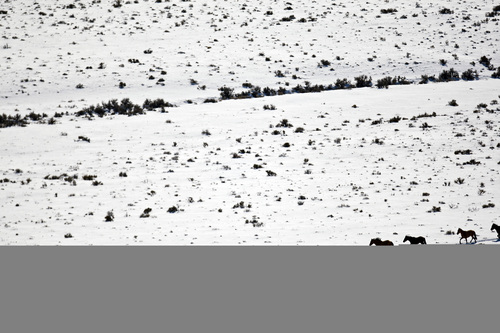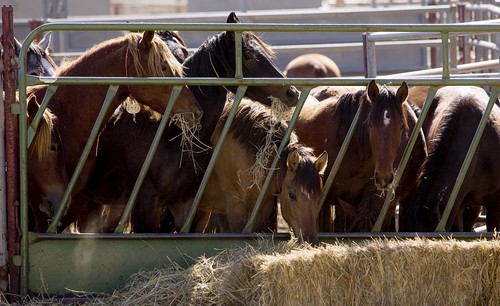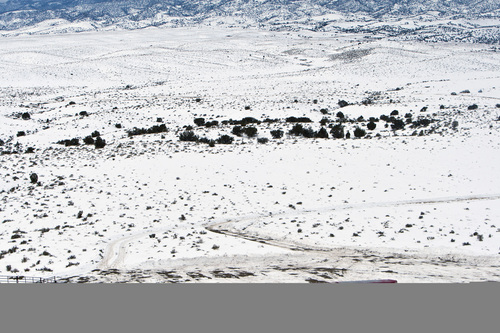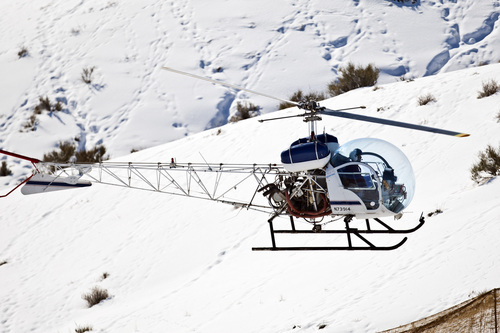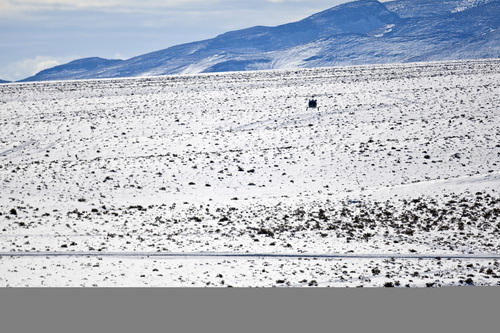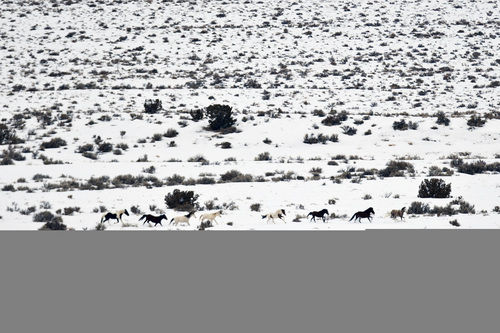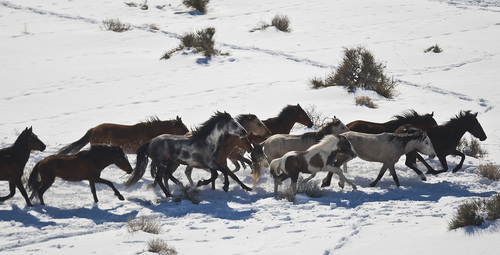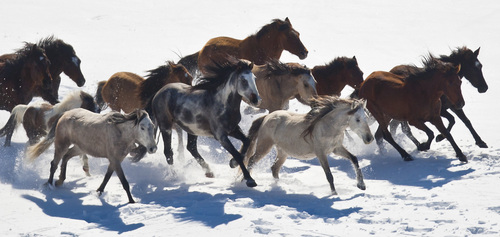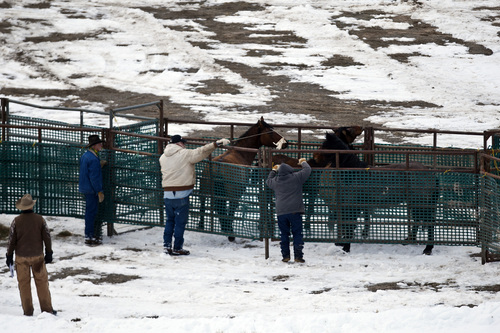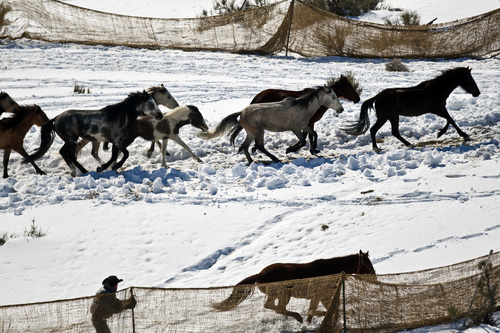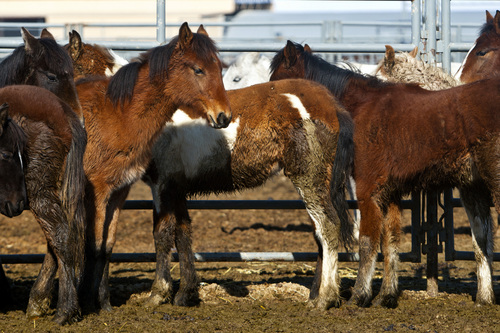This is an archived article that was published on sltrib.com in 2014, and information in the article may be outdated. It is provided only for personal research purposes and may not be reprinted.
Iron County commissioners have given the Bureau of Land Management an ultimatum: Come up with an immediate plan to remove hundreds of wild horses from the area or residents will do it themselves.
As drought damages rangelands in southwestern Utah, the overpopulation of wild horses is threatening livestock and wildlife, said Commissioner David Miller. In response, the Bureau of Land Management (BLM) wants to reduce the number of cattle allowed or "allotted" in grazing leases, Miller said.
"Inaction and no-management practices pose an imminent threat to ranchers who are being pushed to reduce their allotments by 50 percent thereby damaging the value of their private rights," reads a March 30 letter signed by Miller and Iron County Sheriff Mark Gower.
Volunteers are ready, corrals are prepared and feed has been secured in case the BLM does not act promptly, Miller said.
The letter, addressed to BLM Principal Deputy Director Neil Kornze, gives the federal agency until noon Friday to present a plan for removing horses by a "time acceptable to mitigate the threats and adverse conditions" in Iron County.
A BLM management plan says there should be 300 wild horses in the area, but the agency estimates there are 1,200 animals, Miller said.
"We will take whatever action we have to take to reduce those numbers immediately," Miller said Thursday. "We expect the BLM to take that action. If they refuse we cannot wait until the range is destroyed."
Calls to the BLM were not immediately returned.
The Associated Press reported in February that Joan Guilfoyle, chief of the BLM's Wild Horse and Burro Division, told her staff the $70 million program was headed for financial collapse unless "drastic changes" are made in the agency's decades-old roundup policy.
She suggested suspending roundups until thousands of mustangs in federal corrals are sold or adopted, and recommended for the first time euthanizing wild horses on the range "as an act of mercy if animals decline to near-death condition as a result of declining water and forage resources."
The commission, Miller said, has not ruled out euthanizing wild horses it may decide to capture, but that is not the plan.
"There is the high probability that we will find some of the animals do need to be put down for humane reasons due to the poor forage conditions," Miller said. "We intend to be compassionate and very much take a conservationist approach. We are all concerned that the habitat of the western range could be destroyed. Imagine the inhumane components of starving wild horses and wildlife."
Iron County plans to temporarily keep the horses and hope they will be adopted, he said.
Utah Gov. Gary Herbert is aware of the conflict and has expressed his concern to Kornze, said spokeman Michael Mower.
Herbert "understands the frustration felt by West Desert ranchers who have been asked to dramatically curtail the size of their cattle herds while the wild horse herds continue to increase dramatically," Mower said.
Horses were not native to the West when European explorers arrived, and not all those on the range today were born wild. In recent years, people have released horses they couldn't afford to keep.
Utah had an estimated population of 3,245 wild horses and 250 burros as of fiscal year 2013, while the "appropriate management level" for the state was 1,956, according to the BLM's Utah Wild Horse and Burro web page.
The BLM manages the horses and burros under the 1971 Wild Free-Roaming Horses and Burros Act and is allowed to remove excess animals. There are four Utah sites that hold captured horses, and two have enough space to take 531 more animals, according to a March BLM report.
But the act prohibits roundups by others. Those who remove or attempt to remove wild horses or burros from public land without authority could face a fine of up to $2,000 or imprisonment for up to a year, or both.
Maliciously causing the death of the animals, harassing them or capturing one for private use also violates the act.
Miller argues the BLM is breaking federal law by not appropriately managing the herds.
As the chair of the Iron County Commission, he said, he has authority under Utah State Code to arrange a roundup.
"We are charged to mitigate the risk to the health, safety and welfare of the people of Iron County," Miller said. "We are legal."
Across the West, BLM officials collected 4,064 horses and 112 burros in fiscal year 2013 and either put them up for adoption or sent them to long-term holding pastures. More than 8,200 were removed in 2012.
BLM biologists have also made efforts to control populations by fertility control treatments.
The agency has come under Congressional scrutiny for the cost of managing the wild horses and burros, and faced public outcry about the possibility of animals being sold to meat plants.
Miller said the BLM has responded to the county's concerns with the explanation that there isn't enough money in its budget to get the herds to the appropriate level.
The commission counters that argument by pointing to the BLM's spending in its fight with a rancher just across the border in Nevada. According to the March 30 letter, the agency is preparing to round up cattle it wants removed from BLM land.
"The decision of the BLM to allocate funding approaching or surpassing $2 million dollars to gather private cattle owned in Clark County, Nevada while the agency refuses to respond to the requests by Iron County to abide by its own laws and policies is unacceptable," the letter said.
Herbert made that point as well, Mower said. Herbert tried to convey "the frustration of many local officials and ranchers that so much money is being spent on a cattle roundup in Clark County. The BLM seems to have the resources to do that but will not adequately address the issues concerning wild horses," Mower said.
Twitter: @BrettPrettyman —
Wild horses and burros
Under the Wild Free-Roaming Horses and Burros Act of 1971, wild horses and burros are declared to be "living symbols of the historic and pioneer spirit of the West."
Under the law, the Bureau of Land Management and U.S. Forest Service are charged with managing and protecting herds in their respective jurisdictions, while also working to maintain rangeland health.
The BLM's Wild Horse and Burro Program has adopted out more then 230,000 wild animals since 1971.
For more information on how to adopt a wild horse or burro, go to http://on.doi.gov/XcgdjB.


